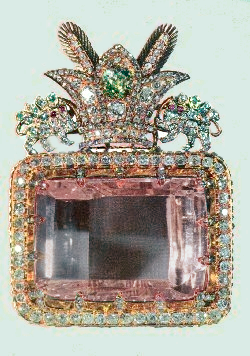Golkonda (Telugu: గోల్కొండ), a ruined city of south-central India and capital of ancient Kingdom of Golkonda (c. 1364–1512), is situated 11 km west of Hyderabad.
The most important builder of Golkonda was a Hindu Kakatiya King. Ibrahim was following in the spirit of his ancestors, the Qutub Shahi kings, a great family of builders who had ruled the kingdom of Golkonda from 1512. Their first capital, the fortress citadel of Golkonda, was rebuilt for defense from invading Mughals from the north. They laid out Golkonda's splendid monuments, now in ruins, and designed a perfect acoustical system by which a hand clap sounded at the fort's main gates, the grand portico, was heard at the top of the citadel, situated on a 300-foot (91 m)-high granite hill. This is one of the fascinating features of the fort. They ruled over the Telangana region and some parts of present day Karnataka and Maharashtra.
The 13th century Golkonda Fort was built by the Hindu Kakatiya kings.The Kakatiya’s ascent to power can be traced to the reign of the Western Chalukyas. Kakartya Gundyana, a subordinate of the Eastern Chalukyan monarch, Amma II (945 CE-970 CE), established the Kakatiya dynasty. The dynasty's name comes either from its association with a town known as Kakatipura (since the kings bore the title “Kakatipuravallabha”) or from their worship of a goddess called Kakati. A temple dedicated to goddess Kakatamma exists in Warangal so Kakatipura could be another name for Warangal itself. Kakatiyas' ancestors belonged to the Durjaya family
Golkonda was located 11 km west of the city of Hyderabad, Andhra Pradesh state, India (location 17°23′00″N 78°24′15″E). According to a legend, the fort derives its name from Golla conda, which is a Telugu word for Shepherd's Hill. It is believed that a shepherd boy came across an idol on the hill. This led to the construction of a mud fort by the then Kakatiya dynasty ruler of the kingdom around the site.
The city and fortress are built on a granite hill that is 120 meters (400 ft) high and is surrounded by massive crenelated ramparts. The beginnings of the fort date to 1143, when the Hindu Kakatiya dynasty ruled the area. The Kakatiya dynasty were followed by the state of Warangal, which was later conquered by the Islamic Bahmani Sultanat. The fort became the capital of a major province in the Sultanate and after its collapse the capital of the Qutb Shahi kings. The fort finally fell into ruins after a siege and its fall to Mughal emperor Aurangazeb.
After the collapse of the Bahmani Sultanat, Golkonda rose to prominence as the seat of the Qutb Shahi dynasty around 1507. Over a period of 62 years the mud fort was expanded by the first three Qutb Shahi kings into a massive fort of granite, extending around 5 km in circumference. It remained the capital of the Qutb Shahi dynasty until 1590 when the capital was shifted to Hyderabad. The Qutb Shahis expanded the fort, whose 7 km outer wall enclosed the city. The state became a focal point for Shia Islam in India, for instance in the 17th century Bahraini clerics, Sheikh Ja`far bin Kamal al-Din and Sheikh Salih Al-Karzakani both emigrated to Golkonda.
The Qutb Shahi sultanate lasted until its conquest by Mughal emperor Aurangzeb in 1687. The fortress held out against Aurangzeb for nine months, falling to the Mughals through treachery.
Kancharla Gopanna, popularly known as Bhaktha Ramadaasu, a devout Hindu who constructed Bhadrachalm temple without informing the sultan at that time Tana Shah, was kept in a jail located inside the fort. Bhadrachala Ramadas
The golconda fort use to have a Vault chamber where once the famous Kohinoor and Hope diamonds were stored along with other diamonds.
Golkonda was once renowned for the diamonds found on the south-east at Kollur Mine near Kollur (modern day Guntur district), Paritala (modern day Krishna district) and cut in the city during the Kakatiya reign. India Diamond History, at that time, had the only known diamond mines in the world.
The Mines of Golkonda themselves yielded diamonds of trifling quantity. Europeans knew that diamonds were found only in these fabled mines. Golkonda was, in fact, the market city of the diamond trade, and gems sold there came from a number of mines. The fortress city within the walls was famous for diamond trade.
Magnificent diamonds were taken from the mines in the region surrounding Golkonda, including Darya-e Nur, meaning sea of light, at 185 carats (37 g), the largest and finest diamond of the crown jewels of Iran.
Its name has taken a generic meaning and has come to be associated with great wealth. Gemologists use this classification to denote a diamond with a complete (or almost-complete) lack of nitrogen; "Golkonda" material is also referred to as "2A".
Many famed diamonds are believed to have been excavated from the mines of Golkonda, such as:
§ Darya-e Nur
§ Nur-Ul-Ain Diamond
§ The Koh-i-noor
§ The Hope Diamond
§ The Regent Diamond
§ Wittelsbach Diamond
Darya-e Nur diamond:

The Hope Diamond

By the 1880s, Golkonda was being used generically by English speakers to refer to any particularly rich mine, and later to any source of great wealth.
During the Renaissance and the early modern eras, the name "Golkonda" acquired a legendary aura and became synonymous for vast wealth. The mines brought riches to the ruling Qutb Shahis of Hyderabad State, who ruled Golkonda up to 1687, then to ruling Asaf Jah of Hyderabad State, who ruled after the independence from the Mughals in 1724, until 1948,, when Hyderabad was annexed, to become an India
source- wikipedia.....








No comments:
Post a Comment